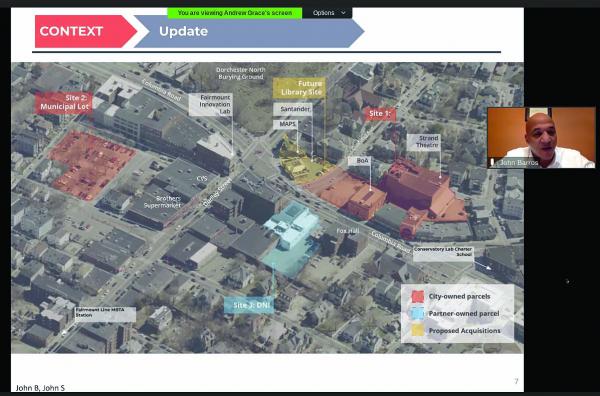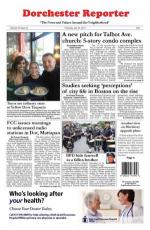November 26, 2020

In a virtual meeting last Thursday, the Boston Planning and Development Agency (BPDA) updated the public on the status of the Uphams Corner Arts & Innovation District, laying out a potential timeline for the three-parcel project, which has stalled in recent years, announcing a few tweaks to the plans, and clarifying a collaborative vision for the neighborhood.
Preliminary plans made in 2017 as part of Mayor Martin Walsh’s “Imagine Boston 2030” program spoke of a revitalized Strand Theatre and a brand new Uphams Corner branch of the Boston Public Library as the key anchors of the project, which would help reestablish the neighborhood as an arts hub and spur “development without displacement.”
After the city conducted a community engagement process in 2017 and 2018, legal issues delayed the release of the project’s Request for Proposals (RFPs), which had been expected in 2019. Then came the coronavirus pandemic, which has delayed planning operations this year.
“It’s been a long time since we’ve been together to discuss the work of implementing the community’s vision and the community’s plan in Uphams Corner,” acknowledged John Barros, the city’s chief of economic development, at the start of the meeting.
The presentation shed some light on the future of three parcels slated for development. Parcel 1 includes the historic Strand, a city-owned property for which the city is seeking a new operator to activate the space with more programming and partner with local organizations to better utilize the space. While there have been conversations about new possibilities or configurations for the interior, most community feedback indicated a wish to preserve the historic nature of the 1,400 seat theater as it is.
An adjoining property also owned by the city— the former Bank of America Building at 555 Columbia Rd. and the Citizens Bank parking lot next door— could be reworked or razed and replaced with a new mixed-use entity, said Andrew Grace, director of economic and strategic development.
“The RFP will allow for the potential to either reactivate the building or remove it and build a new structure there,” he said. “We expect commercial space to remain on the ground floor – we heard a strong preference for local commercial that can remain affordable – and there would be some type of housing development above it, most likely apartments.”
Cushing Avenue, which runs off Columbia Road next to the site, would be included in the development of that area, with the potential to use it as an access point and to improve loading to the Strand.
This core parcel is adjacent to a property containing the Santander Bank branch and the Massachusetts Association of Portuguese Speakers (MAPS) building, which the city envisions as the site of its new branch library. The city is in talks to acquire the property.
“Those negotiations and conversations are far enough ahead that we feel confident that this will be the result,” said BPL president David Leonard, “and we’re moving as quickly as we can to complete those negotiations.”
In a departure from initial plans, the future library building will likely not include mixed-use provisions for housing, as had been previously hoped for. Barros explained that the way the city plans to acquire the property— through a mechanism called a demonstration project plan— prohibits using the site for anything other than municipal use.
“Our vision was to have a mixed-use library, but legally, we don’t think we can do that given how we’re going to acquire the land,” he said. “We spent a lot of time and energy trying to do that, which is why it’s been delayed a little bit.”
Parcel 2 of the project is a city-owned municipal parking lot located next to Hamlet Street behind the CVS and Brothers Supermarket on Dudley Street, which has potential as a commercial and arts-adjacent space.
“The community has said they would like to make sure parking remains there, and that whatever is built, it continues to have parking for the community,” said Barros. “They’ve indicated that a more residential building doesn’t make sense back there— it should be commercial, and it should be complementary to our neighborhood innovation and arts district vision.”
Reflecting that feedback, a stipulation of the RFP for the lot is that any proposed development must include the existing amount of parking spaces.
The Dudley Square Neighborhood Initiative (DSNI) owns Parcel 3 of the project, the former Citizens Bank building at 568-574 Columbia Road, through its land trust, Dudley Neighborhood, Inc. (DNI). Tony Hernandez, managing director for DNI, announced last Thursday that the group is moving forward with the development process independently from the city.
“After what feels like a long pause due to so many things going on in the world, we’re looking forward to rolling this out,” he said. “The big news for DNI is we’re ready to move ahead with an RFP for this former Citizens Bank building, and the goal will be to release an RFP in mid-December.”
Fernandez added that DNI will be looking to designate a developer “no later than late April/early May.” In the meantime, he said, the space in the Citizens Bank building will be rented to a number of local community businesses and organizations until DNI hands it over to the developer, including Boston 24 Fit, Dorchester Bay Economic Development Corporation, Fairmount Innovation Lab, and DSNI.
“I’ve kept my focus on making sure that if I was going to activate this building, it would be activated by those who live locally and are aiming to serve locally,” said Fernandez.
He clarified that DNI is still in collaboration with the city.
“It’s not a breakup, but we’re moving ahead,” he said.
According to the timeline presented in the meeting, BPDA expects to issue RFPs for their sites early next year, with proposals due by spring and a round of community meetings beginning in the summer. A developer would be designated by late summer, and a public review would take place during those months with the goal of submitting funding by the fall.
During the Q & A portion of the meeting, several attendees, including local artists, implored officials to better include artists in the planning stages and to make sure the process doesn’t proceed too quickly.
Tania Anderson, an artist who has put on productions at the Strand in recent years, called for better community outreach.
“When these processes go on, they’re not well advertised to Black and brown people; somehow there’s a disconnect. You need to be more transparent about reaching out to Black artists.”
Jaypix Belmer, a photographer who has lived in Uphams Corner for ten years, asked “How do we get hired in some of these organizations so we can be leads on some of the projects? It’s important that we’re looking to hire in the community.”
Others asked if neighborhood artists would receive priority for any creative space or housing, to which Barros replied “That’s the idea. We’re all about being local first.”
To other concerns about artists being pushed out, Barros, himself a lifelong Uphams Corner resident, pointed to the roots of the project as aiming to drive “development without displacement,” and emphasized the importance of community feedback going forward.
“If what comes back isn’t for the community, we’ll start over. We’re not trying to jam anything down people’s throats. I want people to feel good about this project. I’m amped about this project; this is about making sure this community is for us,” said Barros.



